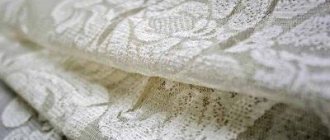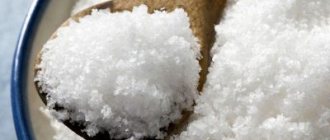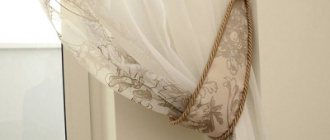The iron has burned out, the lights have been turned off in a hotel or apartment, you just don’t want to bother with ironing, especially if you have to iron curtains or tulle: you never know the situations in which a problem may arise, how to iron things without an iron. There are cases when the material from which an item is made is difficult to iron and to ensure safe smoothing of folds it is necessary to use other methods (in this regard, it is worth special mentioning organza and some knitted products, especially handmade ones).
How can you get rid of unnecessary folds and creases in the material on clothes and apartment decor elements?
Iron with a vinegar solution
You can solve the problem with a solution of 9% vinegar mixed in equal parts with water and any softening agent for clothes. This composition can be used to process any type of fabric or knitwear: cotton, silk and synthetic fibers (organza, from which tulle is often made).
- Pour the mixture into an available container with a spray nozzle (almost anything will do: a spray bottle for treating plants, and an empty bottle of hair serum, it is important that it is clean and allows you to spray the liquid).
- Lay the wrinkled clothes on a flat surface or hang them on hangers and spray evenly until they are slightly damp.
- If this product is made of knitwear, then, in order to avoid stretching, leave it unfolded until completely dry, and if you have treated a fabric shirt or trousers, hang it on hangers.
It is worth noting that in all cases when you remove wrinkles on a knitted item by moistening (steam, wet hands, spray, etc.), you should not put on the treated item immediately; leave it alone until it dries completely to avoid deformation. If the item of clothing is made of slightly stretchable or non-stretchable material, feel free to put on a slightly damp product (for example, a shirt) and dry it on yourself, if, of course, the temperature in the room and your state of health allow it.
Features of working with vertical type devices
The main advantages of a vertical steamer are the ability to iron clothes while hanging and the absence of direct contact with the item. The product is placed on a hanger (sometimes it comes with the device), after which you just need to move the nozzle at a certain distance from the surface of the object. At the same time, the degree of wear of textiles is reduced, the processing is very delicate and effective. After just a few minutes, all wrinkles are smoothed out, germs are destroyed, stains are eliminated.
It is worth considering that in cases of heavy contamination, the device will have to help. Dirt or grease cannot simply evaporate. In some cases, at the initial stage of work, not the most aesthetic stains will appear, there is no need to despair, you just need to work more actively with the steamer. When treating greasy stains, the substance may melt and come to the surface; you just need to remove it with a clean cloth and continue working until the perfect result.
When using a vertical steamer, there are a few things to consider.
- Do not add detergents to the tank unless recommended in the instructions.
- For cheap models, it is necessary to use the purest possible drinking water, otherwise streaks may appear. High-quality and expensive models can also work on tap water.
- The power of the device must correspond to the quality and density of the fabric. Don't try to get quick results by increasing the steam supply.
- You should not send new curtains to the wash; it is better to treat them with a steamer. This will eliminate all specific odors and smooth the surface of the products.
All of the above points apply equally to both floor-standing and hand-held appliances, the only difference is in their power.
Steam ironing
Steam is a great way out of the situation. You can proceed as follows:
- if sufficiently hot water flows from the tap, then you can run a bath, place neatly hung clothes that need ironing above it on a bar or clothes dryer, draw the curtains or close the shower door and leave for about 20 minutes. This method is convenient for relatively large things other than clothes, this way you can smooth out curtains or tulle from which the curtains are made. For small items it is very convenient to use a floor drying rack because... when installed on a bathtub, it makes it possible to hang clothes (for example, a shirt) directly above the steam source;
- To smooth out small wrinkles, you can use a kettle by simply stretching the wrinkled area over the spout of a boiling appliance.
How to iron curtains and tulle
Even if you have an iron, this activity can hardly be called quick and pleasant, especially when you need to iron organza or tulle made of other synthetic or natural fibers, so you can try to optimize the ironing process.
It should be noted that to facilitate the ironing process, some fabrics require pre-treatment. For example, to make it easier to iron organza, after washing the product should be rinsed in water with the addition of table salt (50 g per 10-liter bucket). After this, the curtains can be easily smoothed either with an iron or using any of the methods described above.
You can iron curtains in different ways, the first of which is not to iron them at all. The washed product should be carefully wrung out, or better yet, not wrung out, but simply allowed to drain, and then hung wet on the ledge and leveled. In this form and dry. In most cases, this method is quite justified, especially if you need to iron tulle or curtains made of natural materials. It is unlikely that it will be possible to bring organza into perfect condition in this way, but cotton curtains hang beautifully under their own weight and practically do not need additional ironing. True, if the curtains or drapes are made of dense material, the product, which is heavy with water, may become deformed, which after drying will take on an unkempt appearance. In this case, you can use the steaming method already described above in the bath or shower. Even better for such products would be to use a steam generator or vertical steamer. It will radically simplify the task and allow you to quickly and efficiently iron the most difficult to process fabric, from which tulle is made, including. and organza.
As Baron Munghausen said: “there is a way out of the most hopeless situation.” Common sense and the presence of the Internet to check the correctness of the decision made and search for new ideas can work wonders. Study, analyze and choose the best solution.
Curtains perfectly protect the room from light penetration. In addition, they can play an important role in the interior. Curtains can give a room a unique function; they provide comfort and coziness. Like any other thing, they need care. With the help of modern washing machines, the washing process will not be difficult. Much more pressing is the question of how to iron curtains while hanging. Is it possible to do this? This is what we will talk about now.
Rules for ironing different materials
Each type of tulle has its own ironing characteristics. Therefore, before starting this process, it is recommended that you read the recommendations on the label.
Organza
Organza is a very delicate material that requires a special approach, both during washing and subsequent ironing. This fabric is obtained by twisting thin fibers, which makes it especially delicate. Organza can be made from natural fibers (for example, silk), as well as synthetic ones.
Ironing organza requires special skill. Only the dry option, without moisturizing, which will turn the flat surface of the fabric into a wavy one. It is best to iron through gauze, cambric, tissue paper.
There are several ways to smooth organza:
- Using steam without removing the curtain.
- Using an iron.
- By hanging.
After delicate hand or automatic washing without spinning, carefully straighten the organza tulle and allow the water to drain.
And then immediately hang it on the ledge. Creases formed from twisting or careless drying are difficult to straighten. It's better to prevent them from appearing. According to experts, the best option is steaming with a vertical steamer or steam generator. To get the best effect, it is recommended to do the “procedure” several times. The main advantage of this method is a good result and a gentle effect on the canvas.
If organza is ironed incorrectly, it will no longer look beautiful, creases may appear, or it will even tear.
If you don’t have a steam generator, or you simply consider yourself a supporter of traditional ironing, then you will have to be patient. Ironing organza with an iron is quite difficult and unsafe for the material. Here are some rules to help you:
- The last stage of washing should be rinsing in salted water (1 tablespoon of salt per 5 liters of water). This simple step will prevent the iron from sticking to the fabric.
- Iron only after complete drying. Experts say that if you iron wet organza, it will lose its attractive appearance and glimpses will appear on it.
- In the process, use tissue paper as an “intermediary” between the canvas and the iron.
- Before you start ironing, carefully inspect the soleplate of the iron; it should be perfectly flat and smooth, without burnt areas.
- Do not use steam in a horizontal position, otherwise the material will become wavy.
If you iron organza while wet, it will lose its rich color.
Hanging organza tulle on a curtain rod allows for a natural drying process. This method will require minimal time and effort. Hang the damp tulle in place for 1-2 days; this time is enough for the material to completely smooth out.
An important nuance: if you are going to dry a long curtain using the hanging method, choose the option so that you do not have to fold the canvas along the width or length, otherwise it will be very difficult to iron the resulting crease later. Even steamers are powerless in such situations. Well, if it so happens that the organza curtain has dried even before you hang it up to smooth it, just spray it with water from a spray bottle.
Thin and delicate fabrics will do an excellent job of straightening on their own, taking on a slender and graceful shape. Before ironing very large tulle, make sure there is no burning or deposits on the surface of the iron to eliminate the possibility of unconditional damage to the curtain.
Synthetics
How to smooth synthetic tulle? Nylon and polyester tulle curtains are in particular demand due to their airiness. This material should only be ironed after washing. Hanging after washing will not give the desired result. And in order for the result to please you, you need to follow simple recommendations:
- Synthetic veil, mesh or nylon should be ironed immediately after washing. It is important to iron quickly while the material is still damp. Unlike organza, it is not recommended to wet such tulle with a spray, as persistent stains may appear, which are very difficult to get rid of.
- Choose the right temperature - no more than +120 degrees (this is one or two points on the iron’s temperature dial).
- Do not place the iron directly in the middle of the fabric; first test on an inconspicuous area. If everything is in order, start ironing the entire curtain.
- It is important that there is an “intermediary” between tulle and iron. This can be a damp piece of cotton fabric or a special iron attachment. Silk curtains and polyester curtains are ironed through thin paper.
- You only need to iron on the reverse side. It is only at first glance that it seems that there is no difference which side, they say, they are all the same. If you iron it from the front, barely noticeable yellow stains appear.
- It is recommended to iron the nylon until completely dry, rather than leaving it a little damp.
You can iron the product only when the material is thoroughly and completely dry, otherwise it will lose its external qualities.
Natural cotton tulle
Cotton curtains also have their own care requirements. For example, such curtains are washed only on a delicate cycle, and dried exclusively at minimum speed. If you use another mode, there will be folds on the canvas that will be very difficult to smooth out.
Cotton perfectly absorbs moisture that remains during the washing process. Thanks to this quality, cotton curtains are easy to dry; just hang them up. They will straighten themselves and also dry out under the weight of their own.
Wrinkled tulle made of cotton fabric can be ironed in two ways: with an iron at minimum temperature or without ironing.
To iron heavy types of fabric, they are simply hung out and they straighten under their own weight.
The easiest way is without using an iron. In this case, it is better to abandon the machine spin altogether, and, having taken the fabric out of the machine, simply squeeze it lightly with your hands. Immediately hang the tulle on the curtain rod and place a rag on the floor to absorb the water flowing from the curtains. It will take a long time to dry completely - at least a day - but the result will pleasantly surprise you. Since cotton tulle has considerable weight when wet, it smooths out quite well under its own weight. As a result, the curtain looks as if it has just been ironed.
The main material for Greek curtains is cotton.
If you still want to use the spin function, even at minimum speed, then you will have to iron the tulle with an iron. To do this, select the minimum temperature mode, +100 degrees (this is one point on the iron’s temperature dial). After this, take a piece of damp fabric and iron the curtain through it on the wrong side. This process is quite labor-intensive, and it will take a lot of time to get a good result.
The wet tulle is carefully mounted on the cornice, where the fabric dries, falling freely in beautiful folds. Ironing is permissible with a steamer on the weight or on a board with an iron heated to a maximum of 110 degrees.
Tips and tricks
First of all, it should be noted that ironing is a mandatory process for almost all types of curtains. Of course, you can buy curtains made from an unusually lightweight material that will straighten itself, however, they are often very difficult to find, and not everyone can afford them. Most of us prefer regular curtains.
Here are some basic tips on how to straighten tulle after washing in hot water.
- The iron temperature during ironing is set according to the type of fabric.
- It is best to start the process immediately after washing if the machine provides a strong spin. If washed by hand, give the material some time to dry. That is, you need to iron when the curtains are still wet, without waiting for them to dry. This way the process will be easier. This is especially true for curtains made of thick material.
- Delicate fabric, such as organza, can only be ironed through a special cotton lining. You cannot use colored fabric or newspaper for this purpose. The fact is that due to the components of the dyes, they can stain organza, leaving stains on it.
- To iron tulle, it is better to abandon the steam function.
- Iron the curtains from the right side using gauze or other lining.
Polyester
Polyester is a synthetic material. Nevertheless, it is quite demanding on care, and even more so on ironing. Despite such “capriciousness”, curtains made from this fabric practically do not wrinkle. If the washing was carried out according to all the rules, then they can be hung on the curtain rod slightly damp, and they will straighten out under the influence of their own weight.
If it so happens that the product is heavily wrinkled and it is still necessary to iron it, then you need to use the following rules:
- minimum mode only;
- ironing should be done only on the wrong side;
- It is recommended to additionally cover the curtains with a damp gauze cloth.
How to iron long curtains?
How to iron large tulle Of course, if it is of significant size, then the ironing process becomes difficult.
What to do in this case, because a regular ironing board is not suitable? It simply will not be able to accommodate a large amount of material without the fabric falling to the floor.
In this case, you need to act by starting to iron the curtains from top to bottom. This way, the desired area will always be on the ironing board, and the ironed area can be immediately hung on the curtains.
Smoothing wrinkled tulle
The task is tedious both because of the size of the canvas and its constant sliding off the board. Tulle curtains can be smoothed out well with a steamer, especially if they are decorated with small decorative elements (that do not tolerate hot soles).
Many types of tulle tolerate traditional ironing well. Just don’t forget about the appropriate setting on the iron. Tulle, more than other thin materials, requires a test touch with the heated base of the iron to a piece of fabric. It doesn’t stick, which means you can continue ironing.
Steamer as an alternative
How to iron curtains without removing them? A steamer will come to your aid. Many people purchased this wonderful thing a long time ago and forgot what it was like to use an iron. In the modern product market, steamers of different power and temperature are produced. In this case, manual or vertical devices will be more interesting.
Steam without appliances
To iron curtains by weight, you do not necessarily need to use special equipment. You can use some knowledge. For example, you can remove all folds and wrinkles from the material by hanging wet curtains on a line in the bathroom, filling the bathtub with hot water and closing the door to the room.
About 20 minutes after the steam has exposed the fabric, all you have to do is hang the curtains directly on the curtain rod - they will stretch out and be even.
Important! If creases still remain, you can use steam from the kettle. Just boil water in it, place the spout directly under the crumpled fabric, hold for a minute or two, and that’s it - the curtains will be completely straightened.
Fabric Features
Currently, specialized boutiques offer a wide variety of tulle, which allows you to give each room a completely individual atmosphere - from delicate, almost weightless, to more sophisticated and luxurious.
- “Mesh,” as the name suggests, is a fabric with a perforated texture. This textile comes in many colors, which allows you to fully express your imagination when creating the color of a room. Such tulle will transmit light perfectly. A mesh curtain looks great both as an independent window decoration and as an addition to heavier curtains. However, this type of tulle has one important disadvantage - dust particles accumulate on it very actively, which should be taken into account, especially if you are allergic.
- Organza is a fairly dense and wear-resistant material, despite its lightness and transparency. Polyester is used as the raw material for its production. Dust will not accumulate on this tulle, and it is quite convenient to use - it does not wrinkle and dries quickly.
- Voile is another type of fabric that can last quite a long time. True, unlike the others, it has a matte structure and translucent appearance. Does not require additional curtains. A veil is created from cotton, silk and wool fibers.
- Muslin is a natural or synthetic fabric with a special plain weave that provides it with strength. The material is light and airy, drapes easily, and allows you to create a unique atmosphere in the room.
- Kisey, or thread curtains, is a lightweight fabric made from individual threads of cotton, linen or silk, fastened together only in the upper part. It is distinguished by excellent breathability, lightness, richness of colors and decor.
- Chiffon is a thin, flowing translucent fabric made of silk or cotton. Gives products a sophisticated look and allows you to create noble ensembles in combination with other materials for sewing curtains. But it is not very convenient to process; an unstitched edge can creep along the threads. Also, chiffon curtains are not very durable.
Types of materials and classic ironing modes
Some ironing characteristics differ for different types of fabric. For example, linen curtains should be ironed at maximum temperature. In this case, the canvas should be slightly damp.
For any other type of fabric, more careful processing is required:
- Polyester and viscose are ideal materials. They can amazingly decorate the interior of a room, and any dirt can be washed away from them without unnecessary difficulties.
Important! The ironing temperature for viscose and polyester should not exceed 140 degrees.
- Silk and taffeta do not tolerate steam. These materials are ironed only from the inside.
- In most cases, organza is not ironed. It is hung to dry in such a way that the material straightens during drying. Under the influence of its gravity, the material straightens. However, sometimes creases appear. To eliminate them, iron the curtain fragments at the lowest temperature, using a gauze lining.
- Velvet is one of the most difficult materials to care for. You need to iron it, barely pressing the iron, without resorting to steam.
- If you have embroidery on your curtains, you should wet it and iron it on the other side.
Different ways to heat fabric
Before deciding how to steam an item without a steamer at home, it is important to read the labeling. It is written on the reverse side of the item
Manufacturers often mount fabric surface samples. They can quickly test the reaction to high temperatures and exposure to steam.
When using an iron and hair dryer, be sure to use cotton and gauze cloth soaked in water. This will help avoid deformation of the item and damage to the color of the material. Clothing made of polyester is easy to spoil, even at low temperatures (below 40°C). Insignificant defects, traces of melting and other changes are often formed. They negatively affect the appearance of the item.
If you read the opinions on the forum, the material considered to be demanding is bologna. Winter jackets are often made from it because it is windproof. Bolognese items can only be ironed when wet, during the drying process.
It is quite possible to do without a steamer, as there are three simple ways:
- classic ironing;
- steaming with an iron;
- using a hair dryer.
You can steam things with iron steam
Classic ironing
It is advisable to use a modern iron at home, which has the ability to set the temperature. In the absence of such a function, the device is heated, the power is turned off and allowed to cool to the desired temperature. Check it by spraying clean water.
An iron cannot be called effective if you have to iron deep creases. The impact is performed only from the front side. The item is placed on a hard surface. Then, applying gentle pressure, slowly stroke all areas, moving from top to bottom.
Synthetic components are added to almost all fabrics, which have the property of melting even at low temperatures. You can steam them with an iron only through fabric. This approach helps prevent shiny spots from appearing. For steaming, use wet gauze, which is folded in several layers.
Steaming with an iron
Many modern appliances have a steaming function. It replaces a real steamer in almost all cases. Because steam, which is released under pressure, eliminates dents and creases in the fabric. The item, be it a leather jacket, any outerwear or a wedding dress, is hung in a vertical position on hangers. There should be no contact with the wall or any object.
This method has an important advantage when steaming products made from artificial and natural fabrics - it does not deform the inner layer or press through it. The iron does not come into contact with the item, so there will be no shiny streaks
Steaming starts from the top. First the back side is processed, then the front. The iron is kept at a distance of 10-15 cm from the item. Exposure to steam is carried out briefly, moving to an adjacent area. Strong creases are processed several times. Processing one area for a long time can ruin the fabric.
Exposure to steam in the bathroom
Steam from the bath can straighten some things
Another solution to steaming clothes without a steamer is steam in the bathroom.
If we talk about the jacket, then it is hung in the shower stall for a couple of hours. If there are no pipes for curtains and brackets, you can use a standard mop. It is turned upside down and hung on it with hangers. In order to smooth out deep creases at home, the exposure time is extended by two hours.
Turn on hot water. It will evaporate as the bath is filled. It is necessary to organize the tightness of the room by closing the doors and windows. This method has proven effectiveness. Natural evaporation does not have a negative effect on the fabric and filling of jackets and down jackets. After removing the creases, the clothes are hung on the balcony or any other place that is well ventilated. You must wait until it dries completely.
Hairdryer - ironing with hot air
You can steam things with a hairdryer
When you don't have a steamer or iron, you can use a hair dryer. In this procedure, a wet piece of fabric, a handkerchief or a blanket is additionally used.
The procedure consists of the following steps:
- The blanket is rolled up and the item is placed.
- Cover the place where the hot air of the hairdryer exits with a piece of fabric.
- Turn on high mode.
- Blow the item with a hairdryer, holding it at a distance of about 20 cm.
- The item is left to cool completely.
- If the folds are not completely smoothed out, the procedure is repeated.
After ironing things without a steamer, you don’t need to immediately put them away in the closet. It is recommended to hang them carefully on hangers and let them fully straighten, dry as much as possible and fix their shape. It is advisable to let the item hang for about 2 hours.
Top 10 most popular steamers with discounts
Common Mistakes
Perhaps the most common and common mistake is choosing the wrong temperature.
Even the cheapest iron has several of the most necessary modes. It often happens that the fabric requires low temperatures. However, the person believes that this is not enough, thinking that temperature conditions are chosen “according to taste and color,” and sets the average mode. What is the result? The material is damaged.
Important! Start ironing the curtains from a small area from top to bottom or from the wrong side. Not from the middle of the material, as many people are used to.
Basic mistakes when ironing
Due to inexperience, many housewives spoil curtains during the first ironing. Let's look at the most common mistakes.
- Wrong choice and ignorance of the temperature regime for a certain curtain material. Due to such an error, the fabric begins to shrink in folds, subsequently causing burns and holes. When the defect is somewhere on the edge, you can try to cut off a piece or sew it up somehow, but if there is a hole in the middle of the fabric, the curtain goes to the trash, since even the most experienced seamstress cannot hide such a defect.
- Untimely ironing of fabric. The fabric becomes dry and difficult to iron. You have to constantly moisten it, which can lead to the curtain losing its shape and color.
- Dirty iron or steam generator platform. As a result, the steam comes out dirty and leaves marks on the curtain fabric. It’s not so bad if the curtain is dark, but if the fabric is white, it’s a disaster. You have to remove the curtain again, send it to the wash, dry it, hang it and iron it again. Again, frequent contact of the fabric with water can deform it. To clean carbon deposits on the platform, use a special pencil, which is sold in almost any hardware store. Take care of this in advance so as not to redo the work, save your time and effort.











